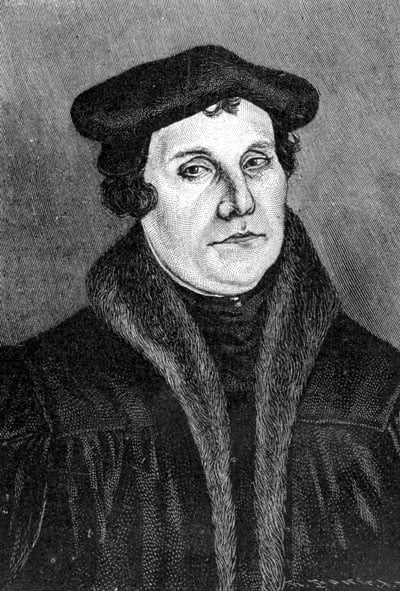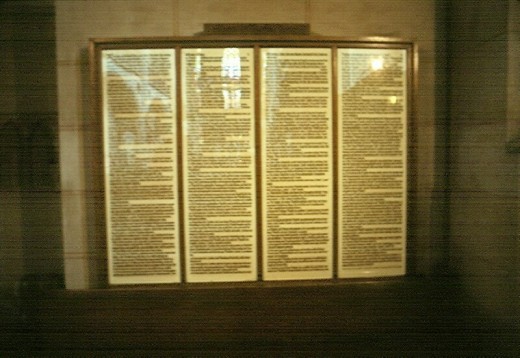The Protestant Reformation (In Ten Minutes)
What was the Protestant Reformation?
The Protestant Reformation was a division within Christianity, instigated as a movement in 1517 in Germany by Martin Luther, John Calvin, and other Protestants. These reformers took issue with many structural and doctrinal institutions within the Roman Catholic church and, spurred on by a diminishing faith in the Catholic church inspired by the Black Plague and the fall of the Eastern Roman Empire, broke off and after decades of conflict and warfare was responsible for the formation of many of the now common denominations of Christianity, including Protestantism, Lutheranism, Calvinism, Moravianism, and Methodism.

The Ninety-Five Theses
Martin Luther's Ninety-Five Theses rejects, among other things, absolution of sin and the sale as well as the concept of indulgences (the dismissal of punishment for absolved sins). They suggest that this commercial view of sin is not actual penance and afforded false assurance since sin could be forgiven only by God.
The Beginning of the Protestant Reformation
The Reformation was inspired by a series of attempts at reform prior to the primary movement under, among others, Jan Hus and John Wycliffe. Faith in the Roman Catholic Church had been on the decline for some time, and people across the continent were extremely receptive to a change.
Spurred on by alleged corruption within the Catholic church, particularly simony, the commerce centered around indulgences, and the absolving of sin, the Reformers saw the perversion of the Church as sinful and exploitative.
Though not the first reformer, Martin Luther is largely credited with starting the Reformation. On October 31, 1517 he posted his Ninety-Five Theses on the Power and Efficacy of Indulgences on the door of the Castle Church in Wittenberg, Saxony. Shortly thereafter with the publication of the Institutes of the Christian Religion in 1536, John Calvin became a pivotal figure in the movement as well. The Reformation was divided largely in two at this point, with one half following Calvin and the other following Luther, in spite of the many similarities in philosophy between the two.
Lutherstadt Whittenburg
The Puritan Movement
The Puritan Movement in England was a Calvinist movement who believed that the Church of England needed further reform and distancing from Catholicism. The most famous of these reformists were the "Pilgrims", who would immigrate to America and establish a colony at Plymouth.
The Reformation Across Europe
In addition to Germany, movements throughout Europe were breaking away from the Catholic church. In England there was the formation of the Anglican church under Henry VIII, which in turn inspired the English Civil War and the Puritan movement. In France, the Reformation took a political turn, gradually weakening the authority of the King and eventually having a direct hand in the instigation of the French Revolution. Scotland, Ireland, Poland, Hungary, Italy, and other countries also saw their own movements, soon seeing much of Europe's conversion to one form or another of Protestantism.

The Thirty Years' War
The conflict between the Catholic church and the Reformists culminated in the Thirty Years' War, one of the single most destructive and longest conflicts in European history. Fought across central Europe, the conflicts began as religiously-motivated but quickly degraded into land-grabbing and political power-plays. Germany, Spain, Austria, Hungary, Sweden, Denmark and others saw the war decimate their populations and destroy large swathes of land.
The Thirty Years' War completely upset the balance of power throughout Europe. Spain fell quickly into decline, and Germany was divided and decentralized. The conflict continued until the signing of the Peace of Westphalia in 1648, which ended both the Thirty Years' War and the Eighty Years' War (between Spain and the Dutch Republic). This group of treaties established national sovereignty, a concept dictating that citizens of a given nation are subject first and foremost to the laws of the state in which they live rather than a foreign entity (such as religious institutions.)
Author's Note
This is by no means a complete history of the Reformation, only what I consider to be the highlights. I apologize if I left out anything that the reader considers important, and will happily add additional information or edit what I already have if demand dictates it.
I hope you enjoyed reading, and as always feel free to track me down on Facebook, or visit my home page for more concise summaries of extremely complex events.









